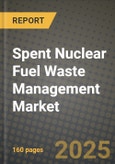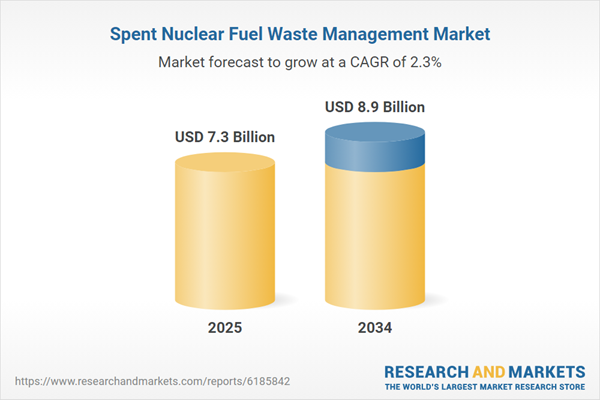The spent nuclear fuel waste management market represents a critical segment of the global nuclear energy infrastructure, addressing the safe handling, storage, transportation, and eventual disposal of high-level radioactive waste. Spent nuclear fuel (SNF), generated after fuel rods are used in nuclear reactors, remains highly radioactive and thermally hot for decades, requiring specialized containment and isolation. Effective waste management is essential not only for public safety and environmental protection but also for ensuring the long-term viability of nuclear power as a low-carbon energy source. This market includes dry cask storage, pool storage, reprocessing technologies, transportation systems, and geologic repository solutions. As nuclear power undergoes a resurgence in response to climate change commitments and energy security concerns, the volume of SNF is increasing globally, prompting governments and utilities to invest more heavily in long-term waste management strategies. The market is shaped by regulatory frameworks, technological advancements, geopolitical considerations, and public opinion, with a growing shift toward permanent disposal solutions and international cooperation on storage capacity and risk mitigation.
The spent nuclear fuel waste management market gained renewed attention as countries expanded their nuclear power portfolios and grappled with aging interim storage facilities. The U.S., France, China, and several Eastern European nations advanced plans for deep geological repositories, while others improved centralized interim storage capabilities. Technology innovation accelerated with the adoption of advanced dry cask systems and enhanced radiation shielding materials, offering better safety and scalability. Political debates over storage site selection continued, particularly in densely populated or geologically sensitive areas. Public resistance remained a challenge in some regions, prompting utilities to improve transparency and community engagement initiatives. Notably, multilateral collaboration grew - especially in the EU - on shared disposal infrastructure and harmonized safety standards. Furthermore, the rising interest in small modular reactors (SMRs) added new dimensions to waste management planning, as their fuel configurations may require adapted storage and transport approaches. Overall, 2024 marked a year of cautious progress, with a strong focus on infrastructure upgrades, policy harmonization, and future-proofing of storage solutions.
The spent nuclear fuel waste management market is expected to evolve toward more permanent and sustainable solutions. Countries are anticipated to move forward with licensing and construction of deep geological repositories, including Finland’s pioneering facility at Olkiluoto, which could serve as a model for others. Emerging economies with newly commissioned reactors will increase demand for interim and long-term waste solutions, spurring international technology transfers and strategic partnerships. Digital twin technologies and AI-powered monitoring systems will gain traction for real-time radiation tracking and predictive maintenance of storage infrastructure. Governments are likely to introduce new regulatory frameworks focused on extended storage lifecycles and resilience to climate-related disruptions. Meanwhile, R&D into fuel recycling and advanced reprocessing methods could reduce the overall waste burden, though commercial viability remains a long-term prospect. As nuclear energy becomes central to net-zero targets, transparent, secure, and technically robust SNF waste management will become a non-negotiable pillar of global energy policy.
Key Insights: Spent Nuclear Fuel Waste Management Market
- Increased global investment in deep geological repositories reflects a long-term commitment to permanent disposal of high-level radioactive waste, particularly in countries with mature nuclear fleets.
- Advanced dry cask storage systems are gaining popularity due to their modularity, transportability, and improved safety features, enabling more efficient interim storage solutions.
- Digital monitoring technologies such as digital twins and IoT-enabled sensors are being adopted for continuous oversight and early warning systems within nuclear waste storage facilities.
- Growing interest in small modular reactors is prompting the industry to explore tailored waste storage and transport methods to accommodate new reactor fuel forms.
- Multinational collaboration on storage and disposal solutions is expanding, especially in regions with limited geographic capacity or resources to develop independent long-term facilities.
- Rising nuclear energy production worldwide, driven by decarbonization goals and energy independence strategies, is directly increasing the volume of spent nuclear fuel that requires long-term management.
- Government mandates for nuclear waste safety and regulatory compliance are compelling utilities to invest in upgraded and more secure storage systems.
- Technological advancements in shielding materials, cask designs, and radiation monitoring systems are making storage safer, more efficient, and easier to deploy at scale.
- Growing public and political awareness of nuclear waste risks is pressuring governments and operators to implement transparent, science-based disposal strategies with community engagement components.
- Public opposition and political delays around permanent storage site selection continue to hinder progress, despite technical readiness, resulting in extended use of temporary solutions and higher long-term costs.
Spent Nuclear Fuel Waste Management Market Segmentation
By Type
- Low-level Waste
- Intermediate-level Waste
- High-level Waste
By Disposal Type
- Near Surface Disposal
- Deep Surface Disposal
By Source
- Nuclear Fuel Cycle
- Research
- Medical
- and Industrial Source
- Military and Defense Programs
By Application
- Boiling Water Reactors
- Gas Cooled Reactors
- Pressurized Water Reactors
- Pressurized Heavy Water Reactors
- Other Applications
Key Companies Analysed
- Veolia Environment SA
- Bechtel Corp.
- Fluor Corporation
- Westinghouse Electric Company LLC.
- SNC Lavalin Group Inc
- John Wood Group
- Posiva Oy
- US Ecology lnc.
- Enercon Services Inc.
- Magnox Technologies Pvt Ltd
- EnergySolutions
- Holtec International
- Posiva Oy
- Ansaldo Energia
- BHI Energy
- Augean PLC
- Studsvik AB
- Perma-Fix Environmental Services Inc.
- Svensk Kärnbränslehantering AB
- Waste Control Specialists LLC
- DermTech Inc
- Chase Environmental Group
Spent Nuclear Fuel Waste Management Market Analytics
The report employs rigorous tools, including Porter’s Five Forces, value chain mapping, and scenario-based modeling, to assess supply-demand dynamics. Cross-sector influences from parent, derived, and substitute markets are evaluated to identify risks and opportunities. Trade and pricing analytics provide an up-to-date view of international flows, including leading exporters, importers, and regional price trends.Macroeconomic indicators, policy frameworks such as carbon pricing and energy security strategies, and evolving consumer behavior are considered in forecasting scenarios. Recent deal flows, partnerships, and technology innovations are incorporated to assess their impact on future market performance.
Spent Nuclear Fuel Waste Management Market Competitive Intelligence
The competitive landscape is mapped through proprietary frameworks, profiling leading companies with details on business models, product portfolios, financial performance, and strategic initiatives. Key developments such as mergers & acquisitions, technology collaborations, investment inflows, and regional expansions are analyzed for their competitive impact. The report also identifies emerging players and innovative startups contributing to market disruption.Regional insights highlight the most promising investment destinations, regulatory landscapes, and evolving partnerships across energy and industrial corridors.
Countries Covered
- North America - Spent Nuclear Fuel Waste Management market data and outlook to 2034
- United States
- Canada
- Mexico
- Europe - Spent Nuclear Fuel Waste Management market data and outlook to 2034
- Germany
- United Kingdom
- France
- Italy
- Spain
- BeNeLux
- Russia
- Sweden
- Asia-Pacific - Spent Nuclear Fuel Waste Management market data and outlook to 2034
- China
- Japan
- India
- South Korea
- Australia
- Indonesia
- Malaysia
- Vietnam
- Middle East and Africa - Spent Nuclear Fuel Waste Management market data and outlook to 2034
- Saudi Arabia
- South Africa
- Iran
- UAE
- Egypt
- South and Central America - Spent Nuclear Fuel Waste Management market data and outlook to 2034
- Brazil
- Argentina
- Chile
- Peru
Research Methodology
This study combines primary inputs from industry experts across the Spent Nuclear Fuel Waste Management value chain with secondary data from associations, government publications, trade databases, and company disclosures. Proprietary modeling techniques, including data triangulation, statistical correlation, and scenario planning, are applied to deliver reliable market sizing and forecasting.Key Questions Addressed
- What is the current and forecast market size of the Spent Nuclear Fuel Waste Management industry at global, regional, and country levels?
- Which types, applications, and technologies present the highest growth potential?
- How are supply chains adapting to geopolitical and economic shocks?
- What role do policy frameworks, trade flows, and sustainability targets play in shaping demand?
- Who are the leading players, and how are their strategies evolving in the face of global uncertainty?
- Which regional “hotspots” and customer segments will outpace the market, and what go-to-market and partnership models best support entry and expansion?
- Where are the most investable opportunities - across technology roadmaps, sustainability-linked innovation, and M&A - and what is the best segment to invest over the next 3-5 years?
Your Key Takeaways from the Spent Nuclear Fuel Waste Management Market Report
- Global Spent Nuclear Fuel Waste Management market size and growth projections (CAGR), 2024-2034
- Impact of Russia-Ukraine, Israel-Palestine, and Hamas conflicts on Spent Nuclear Fuel Waste Management trade, costs, and supply chains
- Spent Nuclear Fuel Waste Management market size, share, and outlook across 5 regions and 27 countries, 2023-2034
- Spent Nuclear Fuel Waste Management market size, CAGR, and market share of key products, applications, and end-user verticals, 2023-2034
- Short- and long-term Spent Nuclear Fuel Waste Management market trends, drivers, restraints, and opportunities
- Porter’s Five Forces analysis, technological developments, and Spent Nuclear Fuel Waste Management supply chain analysis
- Spent Nuclear Fuel Waste Management trade analysis, Spent Nuclear Fuel Waste Management market price analysis, and Spent Nuclear Fuel Waste Management supply/demand dynamics
- Profiles of 5 leading companies - overview, key strategies, financials, and products
- Latest Spent Nuclear Fuel Waste Management market news and developments
Additional Support
With the purchase of this report, you will receive:- An updated PDF report and an MS Excel data workbook containing all market tables and figures for easy analysis.
- 7-day post-sale analyst support for clarifications and in-scope supplementary data, ensuring the deliverable aligns precisely with your requirements.
- Complimentary report update to incorporate the latest available data and the impact of recent market developments.
This product will be delivered within 1-3 business days.
Table of Contents
Companies Mentioned
- Veolia Environment SA
- Bechtel Corp.
- Fluor Corporation
- Westinghouse Electric Company LLC.
- SNC Lavalin Group Inc.
- John Wood Group
- Posiva Oy
- US Ecology lnc.
- Enercon Services Inc.
- Magnox Technologies Pvt Ltd.
- EnergySolutions
- Holtec International
- Posiva Oy
- Ansaldo Energia
- BHI Energy
- Augean PLC
- Studsvik AB
- Perma-Fix Environmental Services Inc.
- Svensk Kärnbränslehantering AB
- Waste Control Specialists LLC
- DermTech Inc.
- Chase Environmental Group
Table Information
| Report Attribute | Details |
|---|---|
| No. of Pages | 160 |
| Published | October 2025 |
| Forecast Period | 2025 - 2034 |
| Estimated Market Value ( USD | $ 7.3 Billion |
| Forecasted Market Value ( USD | $ 8.9 Billion |
| Compound Annual Growth Rate | 2.2% |
| Regions Covered | Global |
| No. of Companies Mentioned | 22 |









